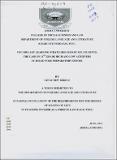| dc.description.abstract | ABSTRACT
The purpose of this study is to identify vocabulary learning strategies (VLSs) used by high and low achievers. Accordingly, a questionnaire and, an interview were designed by adapting Schmitt's (1997) VLSs questionnaire to carry out this study. Fifty four respondents (27 high achievers and 27 low achievers) who were attending 11th Grade at Jorgo Nole Preparatory
School (JNPS) in 2005(E.C.) were involved in the study. In order to strengthen the data obtained through questionnaire, some interview questions were prepared, and ten randomly selected respondents (five from the high and five from the low achievers) were interviewed. Data obtained through the questionnaire were analyzed using Statistical Package for Social Sciences (SPSS) version-16.0. Frequency, percentage, mean and t-test were employed to analyze the data obtained through questionnaire, and the data obtained through interview were analyzed qualitatively. Frequency and percentage were used to show the number of respondents rated the five point’s likert scale for each item. The mean scores were used to compare the difference between the high and the low achievers in using the sub-categories of VLSs. The t-test (at
P<O.05) was used to check if there is statistically significant difference between the high and the low achievers in using each of the VLSs provided to the respondents in the questionnaire, and to assess the relationship between VLSs and their English language achievement. Findings of the study indicate that there is a relationship between the students' perception and their language achievement, and VLSs preferred by the students and their English language achievement, i.e. the high achievers prefer more VLSs than the low achievers to learn and study new vocabulary.
In addition, there is significant difference between the high and the low achievers regarding
VLSs they use since many of the high achievers 'Usually' and 'Always' use almost all of the strategies, whereas many of the low achievers 'Never' and 'Rarely' use many of the strategies to discover the meanings of new English words and to consolidate the words they have learned.
Finally, it is recommended that English language teachers should facilitate the teaching learning conditions in which the high achievers can help the low achievers practice different VLSs that help them to learn and consolidate new English words in order to speed up their English language acquisition. | en |


